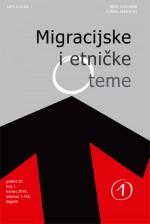Migrant Remittances, Livelihoods and Investment: Evidence from Tsholotsho District in the Matabeleland North Province of Zimbabwe
Migrant Remittances, Livelihoods and Investment: Evidence from Tsholotsho District in the Matabeleland North Province of Zimbabwe
Author(s): Divane Nzima, Vusumzi Duma, Philani MoyoSubject(s): Anthropology, Social Sciences, Economy, Sociology, Social differentiation, Family and social welfare, Demography and human biology, Economic development, Migration Studies
Published by: Institut za migracije i narodnosti
Keywords: migrant remittances; livelihoods; investment; savings; migration; Zimbabwe
Summary/Abstract: This paper traces the developmental contribution of migrant remittances sent from South Africa to the Tsholotsho district of Matabeleland North province of Zimbabwe. Since the discovery of gold in South Africa, Zimbabweans from this region have been migrating to South Africa to seek employment. In recent times, the culture of migration in Tsholotsho continues to strengthen, as women have also joined this previously male dominated livelihood strategy. Debates on migration and development have often centered on the role of remittances as a key instrument for development in migrant sending countries. Governments and multilateral institutions have also taken up remittances as a policy priority with a keen interest. This study was conducted using a mixed methods approach. A total of 159 participants completed self-administered quantitative questionnaires. In addition, 5 in-depth qualitative interviews with key informants were conducted in Tsholotsho, while 10 in-depth interviews with migrants were conducted in Johannesburg, South Africa. The results of this study show that the majority of migrant remittances are largely used for unproductive consumption. However, there also exists a measure of investment owing to the need to satisfy the surging consumer demands within the local economy. In this paper, results have shown that migrant remittances are a key livelihood factor without which many poor people would be severely vulnerable to poverty and hunger.
Journal: Migracijske i etničke teme
- Issue Year: 2016
- Issue No: 1
- Page Range: 37-62
- Page Count: 26
- Language: English

